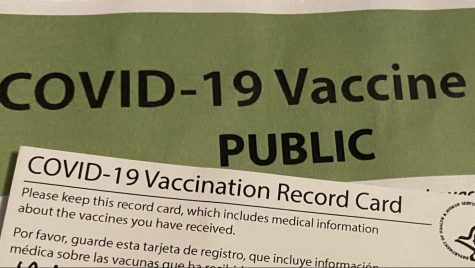COVID Creation
Race to vaccinate creates urgency amid crisis
April 13, 2021

Talk of vaccines took over the news as soon as the pandemic hit, but people watched warily as companies fast-tracked vaccines. A standard vaccine takes years to go from development to distribution, with rounds of testing and studies required before being FDA approved. While this process is tried and true, COVID is anything but standard. It took the world by storm, forcing countries and millions of people into a complete lockdown. Even when full lockdowns were lifted, restrictions left in place seemed suffocating. It quickly became clear that a vaccine was necessary to return to a normal life, and then, the race to finish vaccines began and the world watched to see who developed the vaccine faster than their competitors.
After months of quarantine, mask wearing and COVID contamination, a savior finally arrived. Or, at the very least, the beginning of one. Dec. 15 marked the first shot of the Pfizer vaccine given to combat COVID in the United States, while the first shipments of the shots arrived in Texas on Dec. 14. In phase A, health care workers were among the first to receive the vaccine, followed by residents at long term care facilities (nursing homes), then other emergency responders or public health officials. For phase B, vaccinations opened to teachers, seniors 65 and over or anyone with a health condition that makes them more susceptible to COVID and its symptoms. Vaccination hubs in Texas include CVS pharmacies, various hospitals as well as other local pharmacies or health care providers.
The initial vaccine provided was Pfizer, but as time has gone on two others were approved. The FDA approved both Moderna and Johnson & Johnson since the initial Pfizer shipments in December. All 3 vaccines are being spread state-wide, but the shipment process proves difficult as Moderna and Pfizer must be kept at temperatures below freezing. Moderna can be kept in a freezer at -4°F, then a standard refrigerator for up to 30 days but can only sit at room temperature for 12 hours. Similarly, Pfizer needs to keep an ultralow temperature (-112ºF to -76ºF) and can only be at room temperature for six hours. The latest vaccine to ship out, Johnson & Johnson, stays at a much more manageable temperature of a standard refrigerator. Although, authorities recently placed the Johnson & Johnson vaccine on hold due to the risk of blood clots in patients. Due to the unusual storage requirements, any extra vaccines often go bad if not used during the allotted time window. Since every wasted vaccine puts the state behind, vaccine hubs scramble to use the vaccines before they go bad, which allows some lucky people to get vaccinated long before their expected time frame.
Thanks to the tireless efforts of health care officials and vaccine distributors, over 7.56 million doses of the COVID vaccine have been administered in Texas, with 2.54 million people being fully vaccinated with both doses. Percentage-wise, 8.76% of Texas’ population is fully vaccinated. Out of the total population, the given vaccines don’t seem like a lot, or even a dent in the problem, but every step counts. Once enough of the population receives vaccines, herd immunity comes into question as well as the return of life before the pandemic. After a year of being locked in rooms, escaping infection and only seeing loved ones on facetime calls, the vaccinated future allows everyone to breathe more easily.



